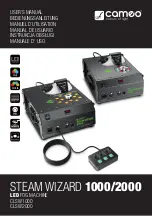Reviews:
No comments
Related manuals for 1600P PROFESSIONAL -

200
Brand: WARRIOR Pages: 45

STEAM WIZARD 1000
Brand: Cameo Pages: 30

611458
Brand: Castex Pages: 9

GC24698-BLHL
Brand: HIGHLEAD Pages: 35

900CPX
Brand: Janome Pages: 26

GBC WireBind W18
Brand: GBC Pages: 38

Magnolia 7360
Brand: Janome Pages: 96

martin yale CR828
Brand: Southwest Pages: 8

AA-2
Brand: Siruba Pages: 10

LT5-H7600-D-N Series
Brand: Unicorn Pages: 55

SW8220
Brand: SOLAC Pages: 48

Proteus 26
Brand: Pacific Pages: 17

SC-330 3
Brand: SCANMASKIN Pages: 62

Crescendo BLCR
Brand: Baby Lock Pages: 216

KX-FP245
Brand: Panasonic Pages: 112

KX-FM255
Brand: Panasonic Pages: 144

KX-FM280
Brand: Panasonic Pages: 172

LSM500ASTRO
Brand: Ibiza Pages: 19

















